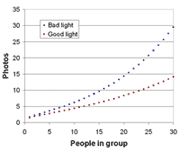I now have a Persian room-mate. He is an interesting guy, a graduate student in History: another one of the few souls who open windows for me to peek into the humanities. Though by no means a devout Muslim, he is now fasting for Ramadan. My other room-mate Irfan has also recently got religion. So every morning Irfan and Sohrab are up by 6 am to eat their little sehri, carefully prepared the previous night: nuts, cheese, cucumbers, some basil leaves and maybe fruit. I am not sure that it resembles the traditional meal, but it sure looks good. The evening's iftaar has more fruits and nuts, and occasionally a spicy Indian upma-like thing that Irfan makes (I have no idea what it's called). Once we had some other Muslim grad students over at our place for the iftaar ritual: they were all Islamic intellectuals discussing the history of the Golden Age and contrasting it (perhaps) with the modern-day politics of the US vis-a-vis Eye-ran and Eye-rack.
When I first heard the word 'iftaar', it was already combined with the word 'party'. In India it is customary during Ramadan for all the Muslim celebrities and politicians to have their little iftaar soirees that are faithfully covered by the Bombay Times (India's # 1 tabloid). In his heyday Mohd. Azharuddin was known to host well-attended iftaar parties. I have never been to one, nor have I ever tasted the special foods of the season that are so talked about in the media in Bombay come Ramadan: malpuas, firni, and other such things.
And I have never shared a house with people fasting for Ramadan before. I am always happy to have the company of religious people, as long as they leave me to my unspiritual ways (unless they are also unscientific, which bugs me). But being in a Muslim house during Ramadan is strangely fun. I am hardly contributing to their ritual, yet merely being around them makes me feel like a part of their noble endeavor, like I am enriched by association. And I don't have to fast for it. In that sense it is similar to other vicariously experienced religious tradition. Tambrams will recognize the feeling: it is like waking up at 6 am to Venkatesha Suprabhaatam (sung by MS, no other version will do) every morning and cribbing about lost sleep, only to realize later that when there's no Suprabhaatam in the mornings something feels oddly lacking: a palpable ambience, a resonance, of religious fervour that I grew up with and associate fondly with childhood. I never wanted any part of it then and I'm not sure I do now. But waking up to an alarm clock is stupid.
I have other fond memories associated with iftaar dinners. I took no part in them except as a spectator, and that too, from a distance. In my college days I often took the bus home from Bandra. It was route 310 to Kurla station via the Bandra-Kurla Complex, Bombay's newest and most high-tech office district (there are direct buses to Chembur, where I live, from Bandra but it's faster via Kurla). Most of the BKC office buildings are built in the modern style, steel superstructures with a facade of highly reflective glass. Old-fashioned BEST double-deckers still ply on route no. 310. I would sit on the upper deck by the window, the evening breeze flapping away at my face, and watch the blazing reflection of the setting sun on the glass windows. As the bus rounded the curve into BKC, the sun's reflection would jump from one gleaming window-pane onto another, taking on deeper and deeper crimson hues until, at last, the skyline behind me obstructed the dying rays and the windows would go dark.
Between the BKC and Kurla station lies a fairly large industrial complex of small lumber yards and iron/steel fence-and-grill workshops, mostly owned and operated by Muslims. Each shop had a long wooden table set outside, and as the bus passed by this busy lane of workshops, I could see small parties of workers at each table, breaking their fast together. The food looked like fruit (mostly melons, I don't know why) and water. There were several food-carts on the street serving some deep-fried delicacy, aromas of which wafted up and made my stomach growl with appreciation. From my semi-distant vantage point this succession of little iftaar dinners appeared to blend together into a large scale communal dinner, so it looked like the entire neighborhood was sitting together at a big banquet to mark the end of another Ramadan day. I have no proof of it but I do believe that the owners of the shops ate with the workers, the rich with the poor. There was a wonderful feeling of community and togetherness about those iftaar dinners.


